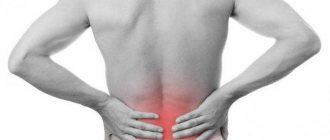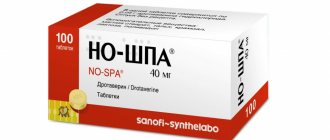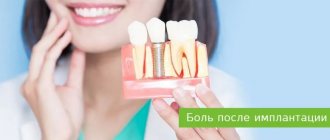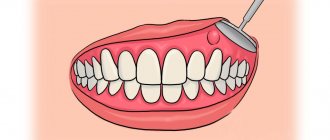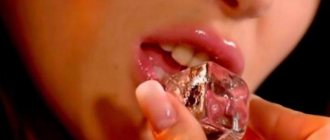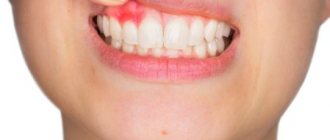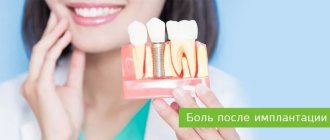What to do if your tooth hurts
Medicines
Folk remedies
Causes
If children have toothache
Toothache can occur unexpectedly and take you by surprise in the most inopportune place. Let's look at how to relieve pain before going to the dentist in this article.
What not to do if you have a toothache
The goal of first aid for dental pain is to alleviate suffering and create tolerable conditions for the patient before going to the dentist. And it is advisable to do this without serious health complications for the sake of five-minute relief. Therefore, it is worth knowing first of all what not to do.
Do not apply heat. If you suffer from acute toothache, it is not recommended to heat either the tooth itself or the cheek. Severe toothache indicates the presence of an inflammatory or infectious process. By applying warm compresses or using other heating methods, you stimulate blood flow to the pathological area. Instead of one diseased tooth, you can get a complication affecting the entire dentition.
If a tooth hurts, it is much more effective to replace warm compresses with briefly applied ice;
Use medications carefully. You cannot blindly believe everything that is written on the Internet. Severe toothache can be effectively relieved or alleviated only in a dental office. All other methods give only an insignificant short-term effect; you should not expect a miraculous cure from them. Do not inject painkillers into the gums yourself, and do not use medications not intended for this purpose to relieve toothache. For example, an aspirin tablet applied to a disturbing tooth can cause severe burns to the mucous membrane, but will not bring relief;
Bed rest is not for you. If you are taken by surprise by an acute toothache, it is better to resist it on your feet or while sitting. The half-sitting position is the very compromise that will allow you to more comfortably endure an unpleasant and exhausting situation and will not cause even more harm to the aching tooth. The fact is that when a person is in a horizontal position, the blood flow to the diseased tooth increases. Increased pressure is created around the already irritated nerve endings and severe toothache becomes simply unbearable. If an acute toothache catches you at night, place the pillows higher, lean back on them and try to take a nap in this position;
Hot rinses and folk remedies. Most ways to relieve tooth pain are based on traditional methods of treatment and pain relief. And the vast majority of recipes advise using hot rinses. You can't do this! But if you use these same herbal decoctions warm, the effect can be very positive, in extreme cases, harmless.
Why are rinses dangerous?
After removal within 1-2 minutes, a blood clot forms in the hole - this is a reliable biological protection of the wound, preventing bacteria from entering it and causing an inflammatory process. It is under no circumstances recommended to destroy, move or wash out this clot. However, during the rinsing process, patients often wash away the protective clot, leaving the socket “dry”. Dry socket is the main cause of alveolitis.
Today, dental surgeons are more inclined to believe that rinsing not only will not help the wound heal faster, but also increases the risk of secondary infection.
What to do if your tooth hurts
First aid for a toothache begins with identifying the causes of the discomfort and eliminating irritating factors. Toothache can be caused by various irritants:
- Hot or cold food and drinks;
- Cold air;
- Sweet, sour, salty foods and drinks;
- Pressure drop;
- Head position;
- By pressure or other influence;
- Food getting into the carious cavity;
- Other mechanical effects on the tooth.
As soon as it becomes clear why the tooth hurts at a particular moment, it is necessary to stop the irritating influence. After this, consult a doctor for help. If the appointment is postponed for a long time, then it is worth taking painkillers.
Tooth structure
The tooth consists of two parts. 1 - The top part of the tooth - the crown, which is visible in the mouth and 2 - the root of the tooth, which extends into the jaw bone to support the tooth in the desired position.
Teeth also consist of:
- enamel - hard outer coating
- dentin - the softer material that supports the enamel and forms the majority of the tooth
- pulp is the soft tissue in the center of the tooth, consisting of nerves, blood vessels and lymphatic vessels.
The root canal system contains the pulp of the tooth and extends from the crown of the tooth to the end of the root, its apex. One tooth can have more than one root canal.
Medicines for toothache
There are many painkillers in pharmacies that are quite effective in helping when a tooth hurts. However, when choosing medications without a prescription and doctor’s recommendations, it is worth remembering that each medicine has a number of contraindications and side effects, so you need to carefully read the instructions, and, if possible, check with pharmacists and pharmacists for information.
The following medications are used to relieve toothache:
| Analgin; | Indomethacin; | Piroxicam; |
| Denebol; | Ketanov; | Solpadeine; |
| Diclofenac; | Ketoprofen; | Tempalgin. |
| Ibuprofen; | Naproxen; |
For local anesthesia and gum disease, Kalgel, Dentinox, Cholisal, Kamistad and Mundizal are suitable. You can also use herbal rinses. They have a calming and antiseptic effect.
Treatment methods
As already noted, in modern dentistry, preference is given to conservative treatment. However, it is often impossible to fully treat tooth root inflammation without surgical intervention.
Conservative treatment
This is a complex methodology that includes several types of activities:
- mechanical cleaning of channels
- disinfection of canals using medications
- Temporary filling with medication
Conservative therapy includes the prescription of antibiotics for inflammation of the tooth root.
Surgery
Involves the operation:
- removal of 1/3 of the root tip
- removal of part of the root (hemisection)
- removal of a tooth from the dental socket
Important: Doctors try to save teeth using all conservative treatment methods available today, since they are successful in 70-90% of cases.
Folk remedies for toothache relief
The most popular folk remedies are also based on rinsing the mouth with a decoction of various herbs, as well as applying various non-heating compresses to the sore tooth.
The most effective rinses are:
| Sage; |
| Oregano; |
| Oak bark; |
| Chamomile decoction; |
| Calendula; |
| A solution of soda, salt and iodine. |
Pain in the teeth is well relieved by compresses or acupressure on the sore tooth. To do this, use tampons or cotton pads soaked in a medicinal solution or containing a medicinal substance. This may serve as:
- Propolis;
- Essential oils;
- Alcohol or strong alcohol;
- Garlic or onion-garlic mixture with salt.
Do not forget about the simplest and surest way to temporarily numb the tooth that is bothering you. Just take an ice cube out of the freezer and apply it briefly to the sore area. The cold freezes and stops all processes, so the pain will subside for a while. Do not apply cold for a long time, as it can chill the nerve endings.
Acute toothache
It appears very unexpectedly and is rapidly gaining strength. Pain in the teeth can be so severe that a person may lose consciousness for a while.
Severe toothache can occur when eating, while talking, while drinking a cup of coffee, when clenching your jaw, turning or tilting your head, climbing stairs, and even just while breathing. During each of these actions, the sensitive tooth will encounter irritants and react with severe pain:
- For hot food or water;
- To cold air;
- To change pressure and increase blood circulation.
In this case, toothache can be short-term, occur only in the presence of irritating factors and subside after their removal, incessant, or it can appear and disappear.
In any case, toothache is a reason to immediately consult a doctor. Without delay and expectation of serious complications.
For what reasons can a tooth root become inflamed?
Despite the availability of many effective methods of therapeutic treatment of inflammation under the tooth root, it is often necessary to resort to the use of surgical treatment methods. This is indicated in the following cases:
- Root canal obstruction was detected
- there is a pin or stump tab that cannot be removed without damaging the root
- there are many cysts - perihilar or growing into the maxillary sinus
- there is a perforation (perforation) of the wall of the tooth root or its cavity
- The use of conservative methods of treating root inflammation does not help
Important:
Most often, periodontitis refers to inflammation in the area of the apex of the tooth root (apical, periapical periodontitis). The cause of tooth root inflammation is untimely treatment of caries and pulpitis. Another type of disease, marginal periodontitis, is classified as periodontology; in this case, the lesion spreads to the gums in the cervical part of the tooth.
Muffled pain in teeth
This is a toothache that a person is used to putting up with and has adapted to live with. It is not as severe as an acute toothache, but it is unpleasant and poisons life. It can be permanent or periodic, occur with a certain pattern, in response to known stimuli, or on its own.
The cause of muted pain is various diseases of the oral cavity. Even the first sensations of pain are a reason to consult a doctor. Most serious illnesses begin with a completely tolerable pain reaction. But if you don’t visit the dentist in time, you can get pulpitis instead of regular caries, and instead of bleeding gums, you can lose a tooth. To prevent this from happening, you don’t have to endure it when your tooth hurts; you need to immediately make an appointment with a doctor.
Prevention
- Preventing any disease is easier than treating it afterwards. This is a true statement, so regular dental checkups should become a good habit. If you live in St. Petersburg, Krasnodar, Novorossiysk or Moscow, then you can contact any of the branches of the INTAN dental network for the best qualified help
- Also, timely treatment of caries and pulpitis will help to avoid periodontitis and its attendant complications. The cost of treating them will be higher and more time will be required.
- In case of acute inflammation at the root of the tooth, a quick visit to the doctor and timely treatment will relieve complications and prevent the process from becoming chronic.
- If caries is detected at any stage, you need to make an appointment with a doctor as soon as possible, undergo an examination and prescribed treatment (remove damaged tooth tissue, filling)
- Compliance with hygiene rules (brush your teeth twice a day with a properly selected brush and toothpaste, use dental floss)
- Diet is important. Dairy products and protein-rich foods, fresh vegetables and fruits should always be on the table. Minimize the consumption of sugar-containing foods and sweet carbonated water.
- Visit your doctor every six months for a check-up and professional teeth cleaning
Following simple rules for oral care will help you avoid inflammation of the tooth root and all the troubles associated with it.
Possible causes of toothache
Caries at different stages can cause pain in the teeth. As a result of poor oral hygiene, tartar forms on the teeth, and as a result, caries develops. Gradually, the tooth enamel will be destroyed, and the internal sensitive tissues of the tooth will begin to be affected. In the first stages of caries development, the tooth may react painfully to hot and cold. When the nerve is already inflamed, toothache may occur as a result of food or water coming into contact with it. Self-medication will not help here: the cause of pain can only be eliminated in a doctor’s office;
abscess or gumboil. Purulent deposits form directly in the gums. In this case, the pain in the teeth is quite sharp and throbbing. There is severe swelling in the oral cavity; in particularly severe cases, the entire cheek may become swollen;
Pulpitis is a logical continuation of advanced caries, which causes severe pain in the teeth. When a tooth hurts due to pulpitis, unexpected severe attacks can be experienced at any time of the day or night, with irradiation into the ear or temple;
Mechanical damage . Tooth trauma, chipped enamel, damage to the crown of the tooth - all this will inevitably lead to pain. If the enamel is damaged, but the nerve remains intact, then pain may not occur immediately, but if you do not consult a doctor in a timely manner, an inflammatory process of the pulp may begin;
Various gum diseases - periodontitis, periodontitis, exposure of the necks of teeth. All these diseases often begin with bleeding gums and have very serious consequences, including tooth loss. Therefore, they definitely require treatment at the dentist’s office.
How does baking soda affect the oral cavity?
Sodium bicarbonate is used for the purpose of prevention or a gentle regime for gum restoration after a tooth has been pulled out or an incision has been made to remove a boil. Soda reduces inflammation, accelerates tissue regeneration, increases the healing effect, slows down the growth of harmful bacteria, and disinfects the wound.
The use of soda when rinsing the mouth is of great importance for the dentist, since it is easier to convince the patient to undergo preventive treatment with soda than with other methods.
Tooth pain in children
An adult can still endure toothache. But when a child has a toothache, it is no less painful for a parent, since it can be very difficult to help in such a situation. Pain in the teeth, or more precisely in the gums, begins in the first year of life, when the baby begins to teethe. In this case, there is no need to urgently run to the dentist for help. A scheduled visit to a specialist as part of a scheduled medical examination is sufficient.
Special teething toys with a cooling effect, toothpastes and silicone brushes for babies, as well as local painkillers will help relieve your baby’s toothache during this period. The most popular and safest for the health of children are Kalgel and Cholisal.
If the problem is not teething, and the baby is worried about something else, for example, problems with the gums or oral mucosa, this is a reason to urgently consult a doctor. Even at such an early age, a dentist can diagnose candida or gingivitis. Proper oral hygiene and timely local treatment will help quickly solve the problem.
Your baby may experience toothache when baby teeth emerge. The very first serious disease is bottle caries. An incorrect diet and prolonged use of a bottle can lead to complete loss of the front baby teeth, so regular visits to the dentist are mandatory from an early age.
After bottle caries, the most common caries of baby teeth can develop. It is very difficult to treat such teeth, since fillings do not adhere well to small teeth. It is much easier and more effective to prevent the development of the disease. Today, pediatric dentistry offers many ways to preserve baby teeth.
Stages of periodontitis treatment
How many times you will have to come to the doctor to treat inflammation at the root of the tooth depends directly on the form of the disease, in remission or during an exacerbation. The course of treatment is also influenced by the method chosen by the doctor. Often, therapy requires a course consisting of several stages of treatment and a visit to the dentist. Until the inflammatory process is eliminated, the tooth cannot be filled, so you will have to visit your doctor several times:
- Preparatory stage. Diagnosis of the condition of the tooth root using x-rays
- When removing the old filling, the tooth is drilled to open access to the canals and remove the nerve
- Channels are expanded to the required size
- Treating the canals with antiseptic drugs and applying medication
- A temporary filling is installed
- At the next visit, the temporary filling is removed and the canals are treated with antiseptic. This stage can last for weeks, or even months - the process will be repeated until the inflammatory focus is completely eliminated and the number of visits will depend on this
- A permanent filling is placed and x-rays are taken again for control.
In addition to the procedures performed in the clinic, the patient must undergo antibacterial and anti-inflammatory therapy. At home, he should do warm rinses with special antiseptic solutions (herbal, medicinal - as recommended by a doctor).
